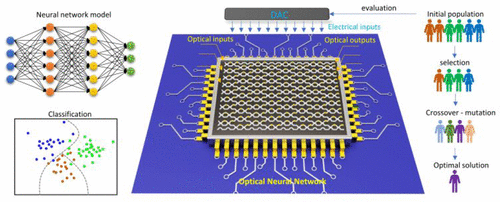当前位置:
X-MOL 学术
›
ACS Photonics
›
论文详情
Our official English website, www.x-mol.net, welcomes your feedback! (Note: you will need to create a separate account there.)
Efficient On-Chip Training of Optical Neural Networks Using Genetic Algorithm
ACS Photonics ( IF 7 ) Pub Date : 2021-04-16 , DOI: 10.1021/acsphotonics.1c00035 Hui Zhang 1 , Jayne Thompson 2 , Mile Gu 2, 3, 4 , Xu Dong Jiang 1 , Hong Cai 5 , Patricia Yang Liu 1 , Yuzhi Shi 1 , Yi Zhang 1, 6 , Muhammad Faeyz Karim 1 , Guo Qiang Lo 7 , Xianshu Luo 7 , Bin Dong 7 , Leong Chuan Kwek 1, 2, 8 , Ai Qun Liu 1
ACS Photonics ( IF 7 ) Pub Date : 2021-04-16 , DOI: 10.1021/acsphotonics.1c00035 Hui Zhang 1 , Jayne Thompson 2 , Mile Gu 2, 3, 4 , Xu Dong Jiang 1 , Hong Cai 5 , Patricia Yang Liu 1 , Yuzhi Shi 1 , Yi Zhang 1, 6 , Muhammad Faeyz Karim 1 , Guo Qiang Lo 7 , Xianshu Luo 7 , Bin Dong 7 , Leong Chuan Kwek 1, 2, 8 , Ai Qun Liu 1
Affiliation

|
Recent advances in silicon photonic chips have made huge progress in optical computing owing to their flexibility in the reconfiguration of various tasks. Its deployment of neural networks serves as an alternative for mitigating the rapidly increased demand for computing resources in electronic platforms. However, it remains a formidable challenge to train the online programmable optical neural networks efficiently, being restricted by the difficulty in obtaining gradient information on a physical device when executing a gradient descent algorithm. Here, we experimentally demonstrate an efficient, physics-agnostic, and closed-loop protocol for training optical neural networks on chip. A gradient-free algorithm, that is, the genetic algorithm, is adopted. The protocol is on-chip implementable, physical agnostic (no need to rely on characterization and offline modeling), and gradient-free. The protocol works for various types of chip structures and is especially helpful to those that cannot be analytically decomposed and characterized. We confirm its viability using several practical tasks, including the crossbar switch and the Iris classification. Finally, by comparing our physics-agonistic and gradient-free method to the off-chip and gradient-based training methods, we demonstrate the robustness of our system to perturbations such as imperfect phase implementation and photodetection noise. Optical processors with gradient-free genetic algorithms have broad application potentials in pattern recognition, reinforcement learning, quantum computing, and realistic applications (such as facial recognition, natural language processing, and autonomous vehicles).
中文翻译:

使用遗传算法对光神经网络进行高效的片上训练
由于硅光子芯片在重新配置各种任务方面的灵活性,硅光子芯片的最新进展在光学计算方面取得了巨大进步。其神经网络的部署可作为缓解电子平台中对计算资源快速增长的需求的替代方案。然而,在执行梯度下降算法时,难以在物理设备上获取梯度信息,因此高效训练在线可编程光学神经网络仍然是一项艰巨的挑战。在这里,我们通过实验证明了一种高效的、物理无关的、闭环协议,用于在芯片上训练光学神经网络。采用无梯度算法,即遗传算法。该协议可在片上实现,物理不可知(无需依赖表征和离线建模),并且无梯度。该协议适用于各种类型的芯片结构,对那些无法进行分析分解和表征的芯片结构特别有帮助。我们通过几个实际任务来确认它的可行性,包括纵横开关和虹膜分类。最后,通过将我们的物理对抗和无梯度方法与片外和基于梯度的训练方法进行比较,我们证明了我们的系统对干扰的鲁棒性,例如不完美的相位实现和光电检测噪声。具有无梯度遗传算法的光学处理器在模式识别、强化学习、量子计算和现实应用(如面部识别、自然语言处理和自动驾驶汽车)方面具有广泛的应用潜力。
更新日期:2021-06-17
中文翻译:

使用遗传算法对光神经网络进行高效的片上训练
由于硅光子芯片在重新配置各种任务方面的灵活性,硅光子芯片的最新进展在光学计算方面取得了巨大进步。其神经网络的部署可作为缓解电子平台中对计算资源快速增长的需求的替代方案。然而,在执行梯度下降算法时,难以在物理设备上获取梯度信息,因此高效训练在线可编程光学神经网络仍然是一项艰巨的挑战。在这里,我们通过实验证明了一种高效的、物理无关的、闭环协议,用于在芯片上训练光学神经网络。采用无梯度算法,即遗传算法。该协议可在片上实现,物理不可知(无需依赖表征和离线建模),并且无梯度。该协议适用于各种类型的芯片结构,对那些无法进行分析分解和表征的芯片结构特别有帮助。我们通过几个实际任务来确认它的可行性,包括纵横开关和虹膜分类。最后,通过将我们的物理对抗和无梯度方法与片外和基于梯度的训练方法进行比较,我们证明了我们的系统对干扰的鲁棒性,例如不完美的相位实现和光电检测噪声。具有无梯度遗传算法的光学处理器在模式识别、强化学习、量子计算和现实应用(如面部识别、自然语言处理和自动驾驶汽车)方面具有广泛的应用潜力。


























 京公网安备 11010802027423号
京公网安备 11010802027423号